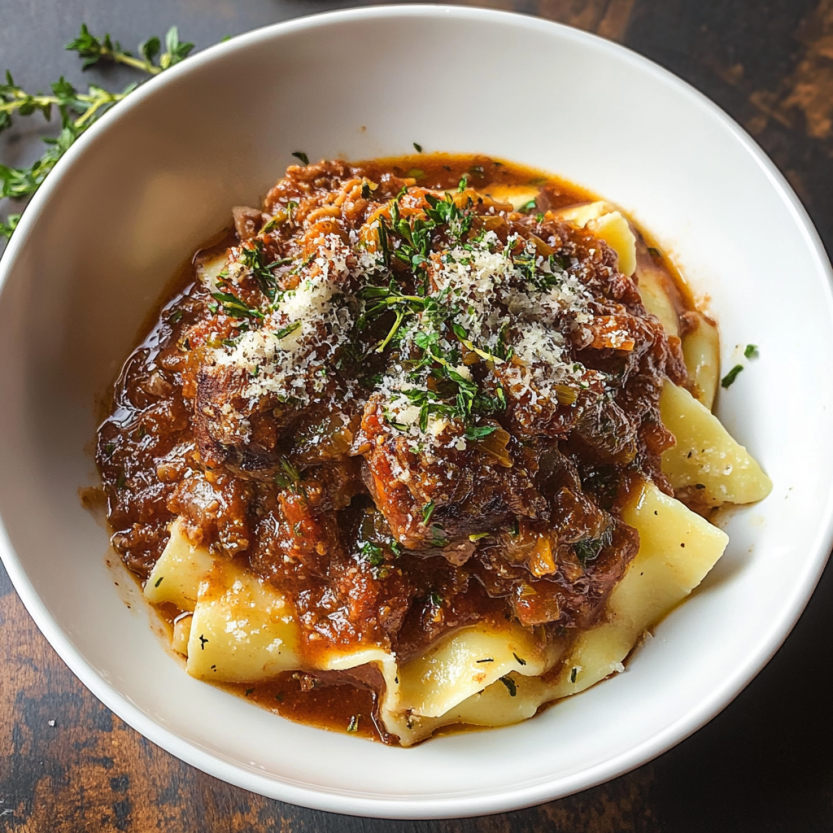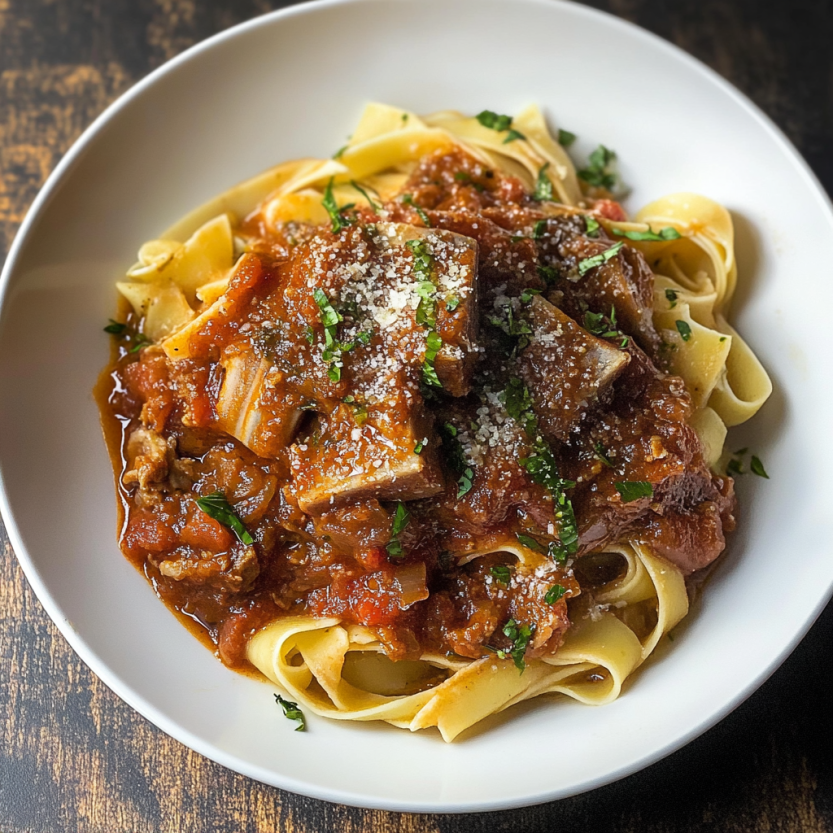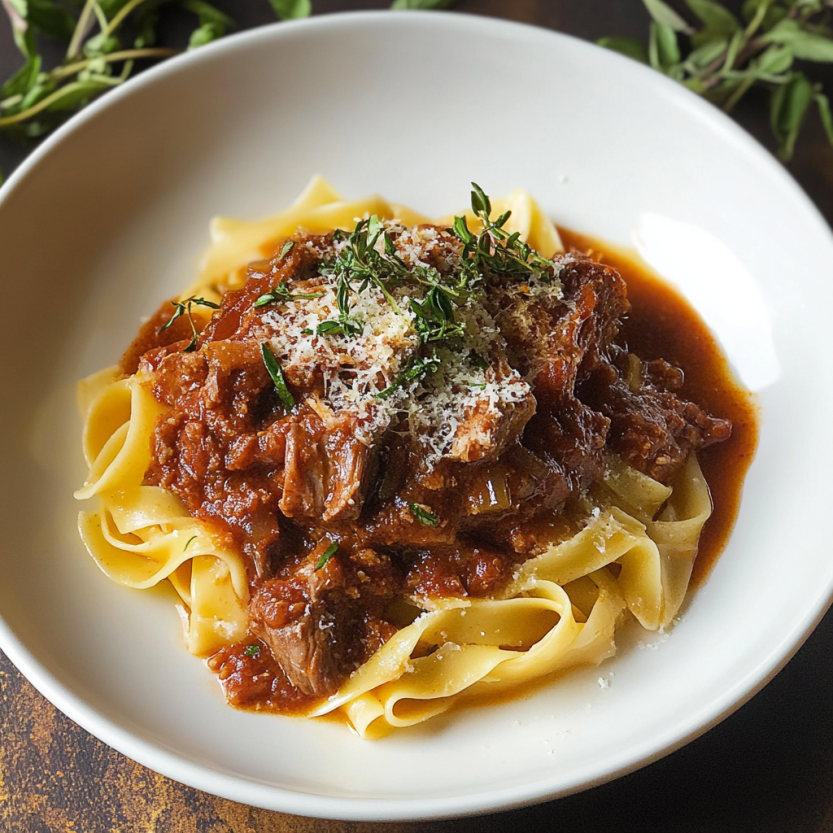 Bookmark
Bookmark
When you cook slow-braised pork shoulder with tomatoes and herbs, your whole place smells amazing. The chunky, tomato-packed sauce hugs each thick noodle, loading every forkful with cozy, old-school vibes. I whip this up when the family's coming over or just so future-me can grab a hearty meal out of the freezer on a busy weeknight.
I pulled this off for the very first time for a Sunday get-together — everyone hung out chatting long after plates were clean. Now, we all want it for birthdays and just lazy weekends too.
Ingredients
- Shredded parmesan cheese: gives a salty, nutty finish — always best to grate it fresh
- Dried or fresh pasta: wide pasta shapes like pappardelle scoop up the chunky ragu best — try local or Italian options
- Sweet Italian pork sausage: breaks up into crispy bits and brings serious meaty flavor — grab one with visible herbs
- Thyme and oregano: these herbs add classic Italian aroma; fresh is subtle, but dried is super fragrant
- Bay leaves: toss in a couple — fresh or dry — for a deeper background taste
- Whole tomatoes pureed: gives a lighter tomato hit — Italian imports are worth it if you've got them
- Crushed tomatoes: thickens the sauce up nicely, pick a brand with just tomatoes and a bit of salt
- Red wine: builds up bold flavor, so don't use anything you wouldn't drink on its own
- Garlic: fresh cloves give the sauce warmth and their smell is unbeatable
- Onion and carrot: chopped together, they sweeten up and layer the sauce with comforting depth
- Salt and pepper: essential for seasoning — an extra pinch or two never hurts
- Pork shoulder: juicy, fatty, and super flavorful — try to trim most of the fat but keep the marbling
- Olive oil: gets searing started and brings a silky richness — extra virgin is best
Step-by-Step Instructions
- Serve It Up:
- Dish out those noodles, pile on more ragu, and don’t skimp on that fresh parmesan — let everyone pass the cheese around.
- Bring Pasta and Sauce Together:
- Pour about half a cup of that reserved water onto the noodles, then top with a good helping of pork ragu. Mix everything, letting the sauce thicken even more. Add extra pasta water if things look dry. You want each pasta strand coated and glossy.
- Cook the Pasta:
- In a big pot of salty water, boil your pasta till it’s perfect for you. Set aside about a cup of that water before draining. Return the pasta to the pot, ready for the sauce.
- Tear Meat and Finish the Sauce:
- Pull out the pork and tear into shreds with forks, so every bit is soft. Ditch the bay leaves. Put the pork back into the sauce, taste and add more salt, pepper, or herbs if it needs it. Let the sauce simmer uncovered for a bit to thicken up while you boil the pasta.
- Let It Gently Bubble:
- Bring the mix to a gentle boil, right away lower the heat, and cover. Let it barely simmer for three to three and a half hours, stirring once in a while. The pork should come apart with just a spoon — that’s how you know it’s ready.
- Toss Pork Back In, Add Sausage:
- Plop the seared pork back into the pot, then drop in the sausage, pinching it into little hunks as you go. Give everything a gentle nudge so it’s all coated in sauce.
- Add Tomatoes and Seasonings:
- Stir in your crushed and pureed whole tomatoes, then add the bay leaves, thyme, and oregano. Scrape the bottom so nothing sticks.
- Splash In Wine:
- Pour in the wine. Scrape all those golden bits off the pan's bottom. Turn up the heat and let the wine bubble till it’s reduced and smells deep and sweet — about five minutes.
- Start the Flavor Base:
- Lower to medium heat, toss in chopped onion and carrot, and another pinch of salt. Stir often as they soften and sweeten (don’t let them brown). Garlic goes in for the last minute, so it keeps its punch without burning.
- Browning the Pork:
- Use paper towels to dry off pork. Season with plenty of salt and pepper. Get olive oil shimmering in your big pot over medium-high, then set in the pork. Let every side get brown and crusty (about three minutes each), making sure those caramelized bits stick to the bottom. Move pork out once all sides are golden.
 Bookmark
Bookmark
Italian sausage is what gets me every time with this one. Tearing up those browned hunks makes me think of being a kid, helping my aunt in her narrow kitchen. That extra sausage right at the end just takes this sauce over the top for me.
Storage Tips
Wait for the sauce to cool down totally, then scoop into airtight containers or freezer bags. You’ll get up to four days in the fridge, three months frozen. Warm it up slow, adding some water to smooth it out. For quick dinners, freeze the sauce flat so it thaws fast.
Ingredient Substitutions
Want something lighter? Use turkey or chicken thighs in place of the pork. If you’re after heat, swap half your sausage for the spicy kind. Gluten-free pasta works fine, or ladle this over soft cheesy polenta if that’s your thing.
Serving Suggestions
This pork ragu really shines with broad noodles — go for rigatoni, pappardelle, or fettuccine. Prefer rustic? Serve it up over creamy polenta or cheesy grits. Add a crisp green salad and some crusty bread, and you've got a killer spread.
 Bookmark
Bookmark
Cultural Context
Making this dish feels like being at an Italian family's long Sunday lunch where stories fly and the food just sticks around. Pork shoulder is famous there for feeding a big group with simple ingredients — it melts right into the sauce. If you’re patient, you get loads of flavor and enough to hand out leftovers.
Frequently Asked Questions About Recipes
- → Is hot Italian sausage a good swap for sweet?
Yep, if you want some kick, just switch to hot Italian sausage instead of sweet.
- → What’s the best pasta shape for this?
Go for wide pasta like pappardelle or fettuccine. They grab onto the chunky, meaty sauce really well.
- → How should I freeze and warm up leftovers?
Let your sauce cool off, scoop into freezer bags, lay flat, and freeze. Thaw it in the fridge overnight, then slowly warm on the stove.
- → Can I cook this in something other than on the stove?
For sure. After browning and the first few steps, you can pop it into a slow cooker on low for about 6–7 hours, or into a 325°F oven for 3 to 3 and a half hours.
- → What red wine should I use?
Try a dry red—Chianti and Sangiovese both work great and give extra flavor.